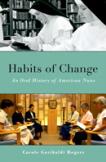The Sisters' Stories
Anyone who is curious about the life of women religious in recent years will be informed and inspired by Habits of Change. Through oral histories collected between 1991 and 1995 and again in 2010, Carole Garibaldi Rogers not only opens the doors of convents but also reveals what was in the hearts and on the minds of almost 100 women religious from 1960 onward.
Coming from more than 40 widely assorted religious congregations with both traditional and progressive leanings, these women were interviewed in 15 states representing most regions of the United States. In the 1990s the interviewees ranged in age from their 40s to their 70s; by 2010 some were in their 90s. Only seven had left the convent in the intervening years, and a few have died. Through skillful editing of much longer narratives, the author offers readers a realistic and poignant portrayal of the “uncommon change” sisters experienced from the 1960s to the present. Each sister discloses her struggles and conveys her sense of fulfillment as she navigated those turbulent years in church and society.
The first section of Part One, “From the Past into the Present,” includes narratives of sisters who served primarily in what Rogers labels “evolving ministries.” Though these were the traditional works of teaching, health care, missionary efforts, spiritual leadership and parish service, the sisters’ innovative insights and fresh approaches instilled new life. In the second section, “changing attitudes,” the themes are different as some sisters moved into more cutting-edge activities—from social and religious protest, to creative arts, to ecumenical engagements. Part Two, “From the Present into the Future,” features the reflections of sisters who “stayed the course” until their deaths in the 1990s; others are “living in the present” in enlivening new ways; and some are “envisioning the future” in dramatically changed circumstances.
The heart and soul of the book are the forthright revelations found in individual narratives. A sense of progression is evident in the lives of these dedicated women. Early along, their focus on spiritual development was superseded by the demands of ministry, with the pressure of teaching large classes and nursing for long hours dominating their lives. One sister who is now in her 80s recalls how exhausted she was all the time with class preparation, sacristy work and convent upkeep. Though she remained faithful to communal observances, she never really had time for prayer on her own. Many years later, when she told a Trappist retreat director that she wanted to spend her retirement learning to pray, he said, “You’ve been in the convent 60 years, and you don’t know how to pray? I am appalled.” Though the comment lacked sensitivity to the demands made on her, she said it shook her to the core. Like many others facing similar situations, she resolved to do what she could to feel God’s presence and listen to God’s voice in her remaining years. For many sisters, priorities eventually shifted and ministry took its proper place in conjunction with prayer, but this balance came years after they entered religious life.
The disproportionate emphasis on interminable work and the pressure to do more is exemplified in many stories. The impact of the collective efforts leap from the pages as sisters recall developing health care clinics for thousands in poor neighborhoods, starting schools for children in nearly abandoned inner cities and remote lands without educational opportunities, leading spiritual renewal in retreat centers and parishes for people hungering to know God, and marching for causes of justice and peace throughout the country. These achievements and contributions to the life of the church are remarkable and bring to mind the great loss the church is enduring as more and more sisters retire. The author wonders, “What would it mean for the Catholic Church—and American society—if nuns were no longer around?”
Perhaps to the surprise of some, the interviews reveal unwavering dedication to community even as living arrangements and ministries changed. For some it is integral to their monastic and contemplative way of life, but even for those in active ministry outside the convent, loyalty to community and church becomes deeper and more precious through the years.
Nonetheless, communal restraints in the form of obedience or custom vexed and infuriated some sisters, especially those who engaged in cutting-edge ministries long before the community was ready to embrace them. Almost all of these well-educated women maintain their commitment to their communities even as some of them speak out for a greater role for women and against both public policy and church directives that prevent participation and muffle their voices.
Almost always the author gets her interpretation just right. She understands and portrays the diversity and complexity of contemporary Catholicism through the all-encompassing interviews. In the prologue, “Where They’ve Been,” she provides a compact recent history of religious life, touching on such key developments as the Sister Formation Conference, the Second Vatican Council and the women’s movement, even up to the recent Apostolic Visitation and Doctrinal Investigation. In the epilogue, “Where They Are Now,” she reflects on the essentials of religious life: cherishing the contemplative dimensions of life, maintaining communitarian bonds, caring for the underserved and remaining grounded in the Gospel. These values are strongly represented in the sisters’ stories of the past.
Neither Rogers nor her interviewees say much about younger religious in new communities and the paths they are following. We would all benefit if she took up the task of finding out.
This article also appeared in print, under the headline “The Sisters' Stories,” in the October 31, 2011, issue.








